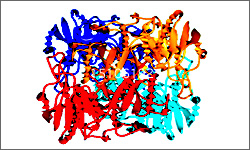Asparaginase

Asparaginase (Erwinaze®) is an enzyme that breaks down (disassembles) the amino acid asparagine which is needed for cell maintenance and growth. In many cases of leukemia, unlike normal cells, the leukemia cells are unable to make their own asparagine (proteins) and must rely on outside sources of asparagine for survival. By reducing free asparagine in the body, asparaginase treatment results in a depletion of cancerous cells while normal cells are more likely to be preserved.1
- 1 Magee Gullatte, M. (2014). Clinical Guide to Antineoplastic Therapy: A Chemotherapy Handbook (Third Edition). Oncology Nursing Society.
Common side effects include nausea and vomiting, loss of appetite. Less common side effects include changes in blood clotting and blood sugar levels and also temporary bone marrow depression. Allergic reactions to this drug are relatively common and can be serious and the chance of reaction is greater in patients that have received this treatment at an earlier time. For this reason asparaginase should only be administered in a hospital setting. Asparaginase often has a negative effect on liver function which may be greater in cases where liver function is already abnormal. This decrease in liver function may cause the toxic effects of other drugs to be greater.1
- 1 Asparaginase. MedlinePlus. [https://medlineplus.gov/druginfo/meds/a612034.html]
